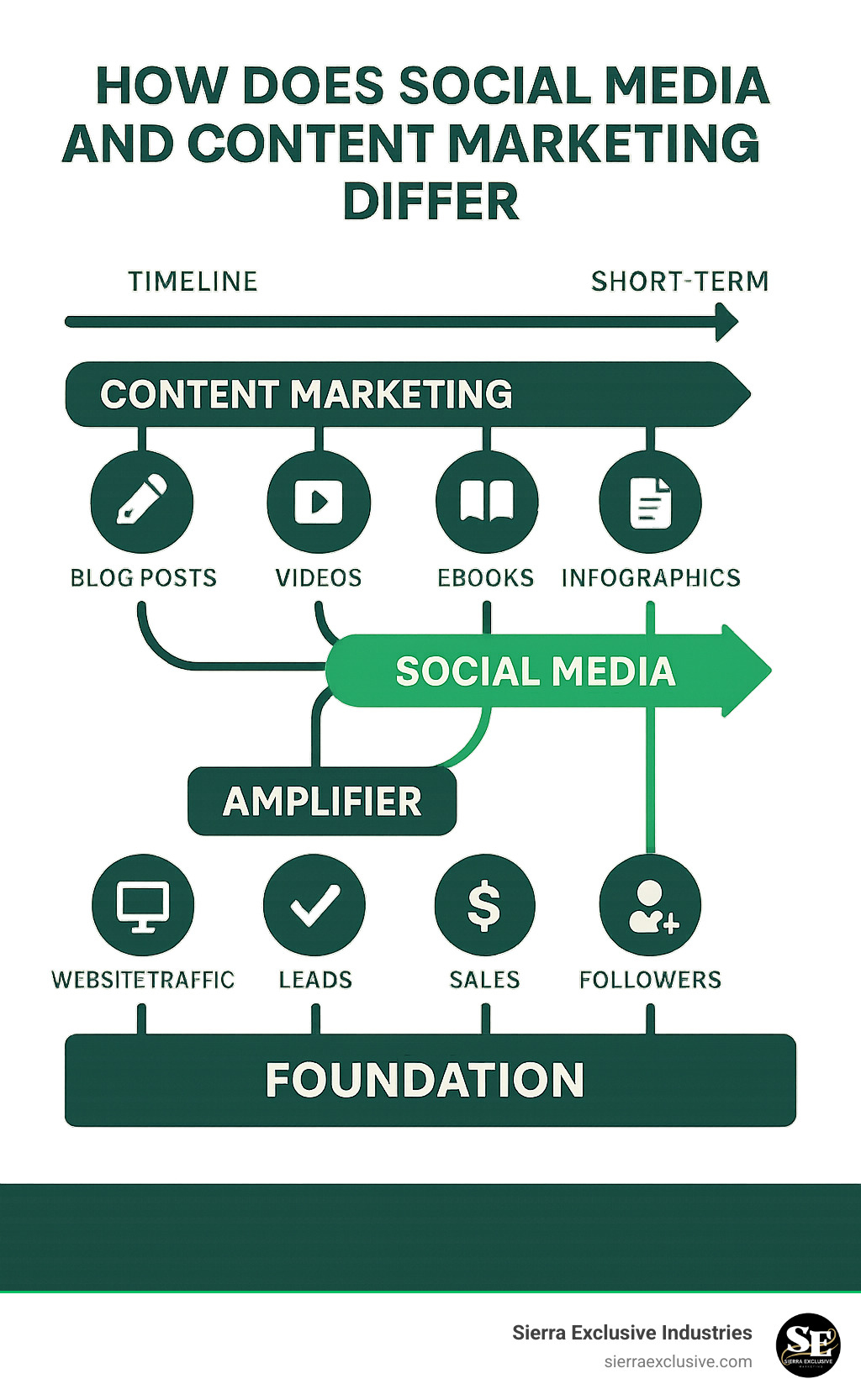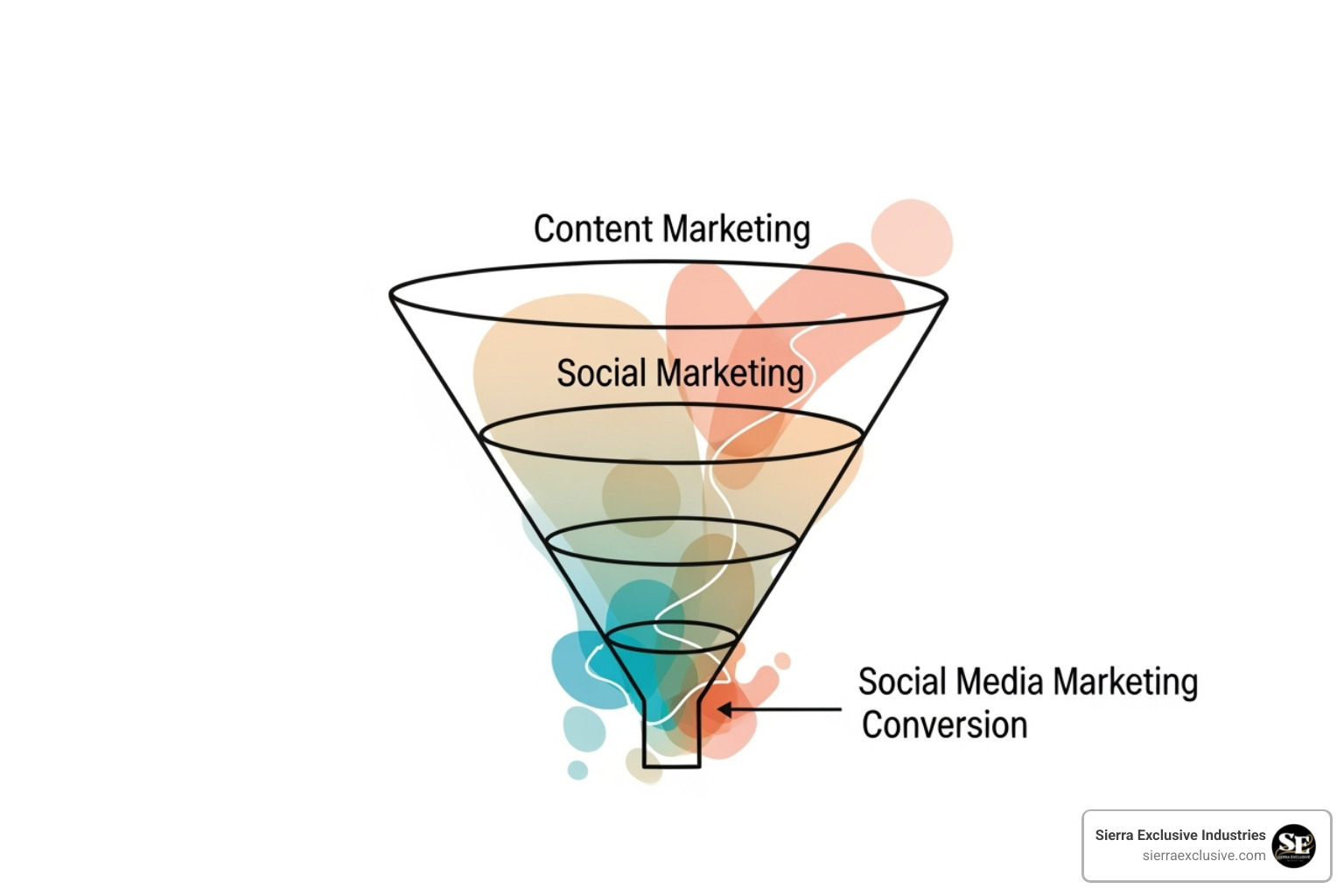Why Understanding Marketing Differences Matters for Growing Businesses
How does social media and content marketing differ is one of the most important questions for any business owner building a scalable marketing strategy. Yet it’s also one of the most misunderstood.
Quick Answer: The Key Differences
| Content Marketing | Social Media Marketing |
|---|---|
| Focus: Creating valuable assets to attract and educate | Focus: Building relationships and community engagement |
| Location: Your website and owned channels | Location: Third-party social platforms |
| Content: Long-form, evergreen (blogs, ebooks, guides) | Content: Short-form, ephemeral (posts, stories, videos) |
| Goals: Website traffic, leads, conversions | Goals: Brand awareness, engagement, followers |
| Results: Long-term, compounding growth | Results: Immediate feedback and quick wins |
Many founders think these two are the same thing. They’re not. As one expert put it: “Think of content marketing as the delicious meal you prepare and social media marketing as the inviting dinner party you throw to share it with others.”
Here’s a better way to think about it:
- Content marketing is a tactic – it’s what you create
- Social media marketing is a channel – it’s where you distribute and engage
Why This Matters for Your Business
Getting this distinction wrong costs you time, money, and growth opportunities. You might create amazing content that nobody sees, or build a huge social following that never converts to customers.
The truth is, they work best together. Content gives your social media substance. Social media gives your content reach and human connection.

Important how does social media and content marketing differ terms:
Defining the Two Heavyweights: Content vs. Social Media
To truly understand how does social media and content marketing differ, we need to start with the fundamentals. Think of these as two different tools in your marketing toolkit – each with its own strengths, purposes, and best use cases.
What is Content Marketing?
Content marketing is your foundation of attraction – it’s the art of creating valuable, helpful content that draws people to your business naturally. Instead of interrupting people with ads, you’re providing something they actually want: answers, insights, and solutions to their problems.
This approach is all about building authority and establishing trust over time. When you consistently publish helpful blog posts, create detailed guides, or share industry insights, you’re positioning your business as the go-to expert in your field. It’s like becoming the friend everyone turns to for advice – except in this case, that advice lives on your website forever.
Content marketing focuses heavily on owned media – that’s your website, blog, email list, and other channels you control completely. This gives you incredible long-term value because every piece of content you create becomes a permanent asset that can attract customers for years to come.
The SEO benefits are huge too. Search engines love fresh, valuable content, which means your blog posts and guides can help you rank higher in search results. In fact, brands that blogged got 55% more website visitors – that’s the power of consistent content creation.
Common content marketing formats include blog posts that answer customer questions, ebooks and whitepapers that dive deep into complex topics, case studies that show real results, infographics that make data digestible, videos that explain concepts visually, and podcasts that allow for deeper conversations. Each format serves a different purpose in educating and entertaining your audience.
Want to see how we approach content creation? Check out our blog for examples of valuable content in action.
What is Social Media Marketing?
Social media marketing is your conversation catalyst – it’s where you go to build relationships, engage with your community, and humanize your brand. While content marketing is like writing a helpful book, social media marketing is like hosting a lively discussion about that book.
The magic happens in the two-way dialogue. Unlike traditional advertising where you broadcast a message and hope people listen, social media lets you have real conversations with your audience. You can answer questions in real-time, respond to comments, and build genuine connections with potential customers.
However, social media platforms are rented media – you don’t own Facebook, Instagram, or LinkedIn. This means you’re playing by their rules and algorithms. While this gives you access to massive audiences, it also means your organic reach can change overnight when platforms update their algorithms.
Social media excels at short-term engagement and creating immediate buzz. You can post something today and see likes, comments, and shares within hours. This makes it perfect for announcements, quick updates, and staying top-of-mind with your audience.
Popular social media platforms each have their own personality: Facebook excels at community building and detailed targeting, Instagram is perfect for visual storytelling and behind-the-scenes content, LinkedIn dominates professional networking and B2B connections, Twitter thrives on real-time conversations and trending topics, and TikTok captures attention with short, creative videos.
The key is understanding that social media marketing isn’t just about posting content – it’s about building relationships and creating a community around your brand. It’s where your business gets to show its personality and connect with people on a human level.
Ready to develop a social media strategy that actually works? Learn more about our social media marketing services and how we help businesses build meaningful connections online.
how does social media and content marketing differ
Here we dive into the specific distinctions that business owners need to understand to allocate resources effectively and set the right expectations for their marketing efforts.

Understanding how does social media and content marketing differ starts with recognizing that while these strategies complement each other beautifully, they serve distinctly different purposes in your marketing ecosystem.
Think of it this way: if your business were a restaurant, content marketing would be perfecting your recipes and creating an amazing menu, while social media marketing would be the friendly host who greets customers and creates buzz about your delicious food.
| Feature | Content Marketing | Social Media Marketing |
|---|---|---|
| Primary Focus | Attraction, Education, Authority, Demand Capture | Interaction, Engagement, Community, Demand Creation |
| Core Asset | Valuable, in-depth, evergreen content | Short, engaging, platform-specific posts |
| Location | Owned channels (website, blog) | Rented channels (social media platforms) |
| Longevity | Long-term, compounding, evergreen | Short-term, ephemeral, real-time |
| Time Horizon | Marathon, results build over months/years | Sprint, immediate feedback, quick wins |
| Goal | Leads, conversions, SEO, thought leadership | Brand awareness, engagement, customer service |
| Measurement | Website traffic, leads, conversions, organic rank | Likes, shares, comments, follower growth, reach |
| Relationship | Builds trust through knowledge | Builds trust through interaction |
Focus and Purpose: The Core Mission
The heart of content marketing lies in capturing demand that already exists. When someone searches “how to increase sales” at 2 AM, your comprehensive blog post is there to help them. Content marketing attracts people who are actively looking for solutions, then nurtures them through valuable information until they’re ready to buy.
We create content that establishes your business as the go-to expert in your field. Every blog post, ebook, and case study builds your reputation as someone who truly understands your customers’ challenges. It’s about being the helpful resource that people bookmark and share with colleagues.
Social media marketing takes a different approach entirely. It focuses on creating demand by sparking interest and conversations. Instead of waiting for people to find you, social media puts your brand directly in front of people as they scroll through their feeds. It’s about building relationships, humanizing your brand, and being part of the daily conversations your audience is having.
Social media excels at brand awareness, customer service, and direct interaction. When a customer tweets a question, you can respond immediately. When industry news breaks, you can join the conversation in real-time. This immediacy creates a completely different type of connection than content marketing offers.
For businesses looking to expand their reach, understanding how to build brand awareness online becomes crucial in leveraging both strategies effectively.
Content Formats and Longevity: The Assets You Create
Content marketing formats are built to last. We create in-depth, evergreen content that remains valuable for months or years. A comprehensive guide on industry best practices written today might still be driving traffic and generating leads three years from now. These assets include long-form blogs, detailed guides, valuable ebooks, and educational webinars that provide substantial value to your audience.
The beauty of content marketing lies in its longer shelf-life. Unlike a social media post that might be seen for a few hours, a well-crafted blog post can attract visitors through search engines for years. This compound effect means your content investment keeps paying dividends long after the initial work is done.
Social media marketing operates in a completely different timeframe. Content here is ephemeral and bite-sized, designed for immediate consumption and quick engagement. We’re talking about visual-heavy images, short videos, engaging stories, and interactive polls that capture attention in the moment.
Each social media platform has its own content preferences. What works on LinkedIn looks completely different from what succeeds on TikTok. This platform-specific approach means we’re constantly adapting our message to fit where your audience spends their time.
Goals and Metrics: How You Measure Success
Content marketing success revolves around driving qualified traffic to your website and converting visitors into customers. We measure website traffic growth, lead generation through downloads and form submissions, actual conversions that impact your bottom line, and improved search engine rankings that bring organic visibility.
The most telling metric is often time on page – when people spend several minutes reading your content, you know you’ve provided real value. We also track how your content gets shared and referenced by others, building backlinks that further boost your search rankings.
Research shows that 83% of B2B content marketers say their strategy increased brand awareness, proving that quality content creates lasting impact.
Social media marketing metrics focus on immediate engagement and audience growth. We track likes, shares, and comments to gauge how well content resonates, monitor follower growth to see audience expansion, and measure reach and engagement rate to understand content effectiveness.
These metrics provide instant feedback. You can post something in the morning and know by afternoon whether it connected with your audience. This real-time data allows for quick adjustments and helps us understand what content styles work best on each platform.
Timeframe for Results: The Patience Game
Content marketing is undeniably a long-term investment. The results are compounding, meaning each piece of content builds upon previous work to create momentum over time. SEO benefits from content marketing can take months to fully materialize, and building true authority in your industry is definitely a marathon, not a sprint.
But here’s what makes the wait worthwhile: once your content starts ranking and attracting organic traffic, it continues working for you 24/7 without additional ad spend. A blog post that ranks well can generate leads for years.
Social media marketing offers immediate feedback and the potential for quick wins. You can launch a campaign and see results within hours. A well-timed post can go viral, bringing instant brand visibility. This real-time engagement makes social media perfect for timely campaigns, customer service, and capitalizing on trending topics.
The trade-off is that social media success requires consistent effort. Unlike evergreen content that works while you sleep, social media demands regular posting and engagement to maintain momentum. But for businesses needing quick brand awareness or immediate customer interaction, this real-time nature is invaluable.
A Power Couple: How Content and Social Media Work Together
Instead of a rivalry, think of these two as a partnership. This section explains how to integrate them for a strategy that’s more powerful than the sum of its parts.

The real magic happens when you stop thinking about how does social media and content marketing differ as competing strategies and start seeing them as dance partners. Content marketing creates the music, and social media marketing teaches it how to dance. They’re not rivals—they’re a power couple that achieves more together than either could alone.
Think of it this way: you wouldn’t throw a dinner party without preparing delicious food, and you wouldn’t cook an amazing meal without inviting people to enjoy it. That’s exactly how content and social media work together in your marketing strategy.
Social Media as the Amplifier
Social media transforms your content from a whisper into a megaphone. It takes your carefully crafted blog posts, ebooks, and videos and broadcasts them to audiences you might never reach otherwise. This isn’t just about posting a link and hoping for the best—it’s about strategic distribution that multiplies your content’s impact.
When you share blog posts on social media, you’re not just driving traffic back to your website. You’re starting conversations, encouraging shares, and creating multiple touchpoints with your audience. A single blog post can become a week’s worth of social content when you extract key quotes, create engaging visuals, and spark discussions around your main points.
Promoting ebooks and whitepapers through social channels transforms these high-value assets into lead magnets. You can create teaser content that highlights the most compelling insights, build anticipation with behind-the-scenes content, and use social proof from early readers to encourage downloads.
Announcing webinars and events becomes exponentially more effective when you leverage social media’s real-time nature. You can build excitement, share speaker highlights, and create countdown posts that drive registrations and attendance.
One company saw a remarkable 351% increase in Facebook impressions and a 644% leap in Facebook engagement when they treated social media as their content amplifier rather than a separate entity. Another business achieved a 209% increase in sessions from social media by combining their social strategy with their SEO efforts. These results demonstrate the power of integration.
For businesses looking to maximize their content’s reach, we’ve developed comprehensive strategies that treat social media as the distribution engine for valuable content. More info about creating a Content Promotion Plan shows how we help companies systematically amplify their message across multiple channels.
Content as the Substance
While social media provides the reach, content provides the reason people should care about your brand in the first place. Without substantial, valuable content backing up your social presence, even the most engaging posts feel hollow. Your content is what transforms casual followers into loyal customers and advocates.
Giving social media depth means your posts aren’t just announcements—they’re valuable resources. Instead of simply saying “We’re experts,” your content proves it through helpful articles, insightful videos, and practical guides that solve real problems for your audience.
Building credibility happens when your social media consistently points to well-researched, thoughtful content. When someone finds your brand through a social post, they can immediately dive deeper into your expertise through your blog, case studies, or educational resources.
Answering questions raised on social becomes an opportunity to create comprehensive content. Those common questions that pop up in your comments or direct messages? They’re goldmines for blog post ideas, FAQ sections, and educational content that serves your entire audience.
Providing value beyond a tweet is where content marketing shines. Social media can start the conversation, but content marketing provides the complete answer. It’s the difference between giving someone a taste and serving them a full meal.
Turning followers into leads requires content that’s worth exchanging contact information for. Social media can introduce people to your brand, but content marketing gives them compelling reasons to take the next step in their customer journey.
We understand that social media builds trust through interaction, while content builds confidence through knowledge. When these two work together, they create a comprehensive experience that addresses both the emotional and rational aspects of decision-making. More info about Social Media Marketing Strategies explores how we integrate content depth with social engagement for maximum impact.
Best Practices for Integration
The most successful businesses we work with don’t treat content and social media as separate departments—they create unified strategies where each amplifies the other. Maintaining a cohesive brand voice across all channels ensures that whether someone finds you through a blog post or a social media post, they have a consistent experience that builds recognition and trust.
Repurposing long-form content into social snippets maximizes the investment you make in content creation. A single comprehensive blog post can become multiple social posts, each highlighting different insights or appealing to different segments of your audience. This isn’t about copying and pasting—it’s about adapting your message to fit each platform’s unique characteristics and audience expectations.
Using social listening to inform your content strategy turns your social media presence into a research tool. The questions, concerns, and discussions happening in your social channels provide invaluable insights for creating content that truly resonates with your audience’s needs and interests.
Creating a unified content calendar ensures that your content creation and social media distribution work in harmony rather than competing for attention. This strategic approach means your social posts support your latest content, your content addresses topics trending in your social channels, and everything works together toward your broader marketing objectives.
Cross-promoting channels creates a virtuous cycle where your social media encourages newsletter sign-ups, your blog posts drive social follows, and your email content gets shared on social platforms. This integration multiplies the value of every piece of content you create.
The businesses that understand this integration—that stop asking how does social media and content marketing differ and start asking how they can work together—are the ones that build truly sustainable, scalable marketing engines.
Frequently Asked Questions about Content and Social Media Marketing
Does content marketing include social media?
This is where many business owners get confused, and understanding how does social media and content marketing differ helps clarify the relationship. Content marketing is the broader strategy of creating valuable assets to attract and engage your audience. Social media marketing is a specific channel and tactic used to distribute that content and build relationships.
Think of it this way: social media is a crucial part of a content marketing strategy, but it’s not the whole picture. Your content marketing strategy includes blog posts that live on your website, ebooks that capture leads, webinars that showcase expertise, and other valuable assets you own. Social media helps amplify this content and creates conversations around it.
So yes, social media is included in content marketing, but content marketing is much bigger than just social media. It’s the foundation that gives your social media posts substance and credibility.
Can a business succeed with only one strategy?
Technically, yes – but it’s like trying to drive a car with only three wheels. You might move forward, but you’re missing out on stability and speed.
A business that focuses solely on content marketing might create incredible, valuable resources that solve real problems. But without active distribution channels, these amazing assets might sit on their website gathering digital dust. No one knows they exist.
On the flip side, a business relying only on social media marketing might build a large, engaged following and generate plenty of buzz. But when followers are ready to make a purchase decision, they need deeper information and proof of expertise. Without substantial content to back up the social presence, that audience often lacks the confidence to convert into paying customers.
The magic happens when you use both together. Content provides the depth and authority, while social media provides the reach and human connection. They create a powerful cycle where each strengthens the other.
How do I know which to prioritize for my business?
While the ideal approach integrates both strategies, your immediate priorities depend on your industry, business model, and current goals. Here’s how to think about it:
Prioritize content marketing first if you’re in a high-trust industry like finance, healthcare, or legal services. These fields require building authority through in-depth, expert information. Also focus on content if you have a long sales cycle where customers need education and nurturing over months, or if your goal is establishing long-term thought leadership and sustained organic traffic.
Prioritize social media marketing first if you’re a startup needing quick brand awareness in a crowded market. It’s also the right choice for B2C companies focused on building community and direct customer engagement, or if your product is highly visual and works well in short, engaging formats. Social media is perfect when you need to create demand quickly or provide real-time customer service.
For most growing businesses aiming for that first $1 million in revenue, we recommend starting with a content foundation and then amplifying it through social media. This approach builds lasting value while creating immediate engagement opportunities.
The key is understanding that both strategies serve different purposes in your growth journey, and the most successful businesses find ways to make them work together harmoniously.
Conclusion: Building Your Integrated Marketing Engine
Understanding how does social media and content marketing differ is just the beginning of your marketing journey. The real magic happens when you stop seeing them as separate strategies and start viewing them as two parts of the same powerful engine.
Think of it this way: content marketing is like building a beautiful house with solid foundations, quality materials, and thoughtful design. Social media marketing is like throwing the perfect housewarming party that brings people inside to experience what you’ve built. One without the other leaves you with either an empty house or a party with nothing substantial to offer guests.
Content marketing provides the substance – the valuable insights, helpful guides, and expertise that establish your authority. It’s what turns casual visitors into educated prospects and eventually into loyal customers. This is your long-term foundation for growth.
Social media marketing provides the spark – the conversations, connections, and immediate engagement that breathe life into your brand. It’s what makes your business feel human and accessible, creating those crucial first impressions and ongoing relationships.
When you integrate both strategies effectively, something remarkable happens. Your content gets the audience it deserves, and your social media gets the depth it needs to convert followers into customers. You create a sustainable marketing engine that works around the clock – attracting new prospects through valuable content while nurturing relationships through social engagement.
The businesses that thrive in today’s digital landscape aren’t the ones that choose between content and social media. They’re the ones that master the art of making them work together seamlessly.
At Sierra Exclusive Industries, we help emerging and growing businesses build exactly this kind of integrated marketing engine. We understand that reaching your first $1 million in annual recurring revenue requires more than just creating good content or posting regularly on social media. It requires a strategic approach that leverages both to create compounding growth.
Our proven, data-driven framework helps you develop content that educates and converts while building social media strategies that amplify your message and foster genuine connections with your audience. We’re committed to delivering measurable impact and sustainable growth that positions your business for long-term success.
Ready to stop choosing between content and social media and start making them work together? Learn more about our Social Media Marketing services and how they fit into a larger growth framework.




